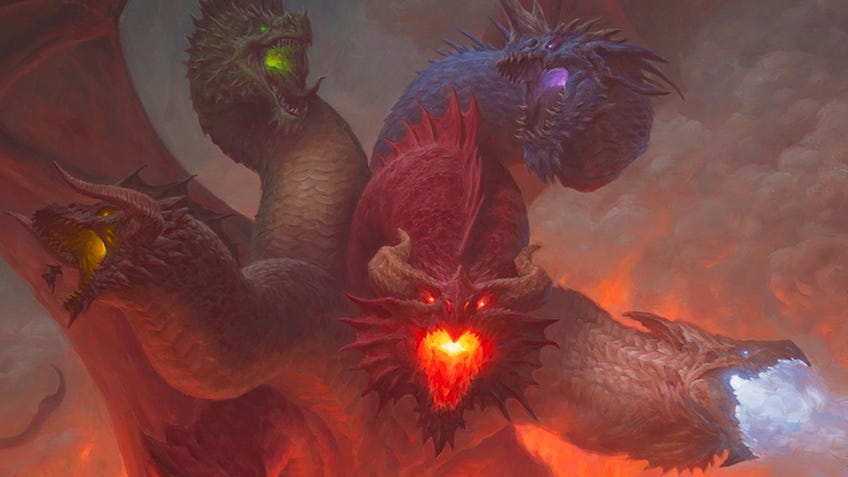The best D&D references in MTG's Adventures in the Forgotten Realms set
From character classes to critical rolls.
Adventures in the Forgotten Realms is the latest Magic: The Gathering set and, alongside being one of the more cumbersome set titles (people are shortening it to Forgotten Realms, which isn’t too bad), it’s also the first major crossover set. It’s not just any crossover either, as this is a set built from the ground up with the help of the Dungeons & Dragons team to bring the tabletop RPG into the card game for the very first time.
There have always been hints of D&D in MTG just by the very nature of their settings - what with elves, dwarves and goblins being an integral part of both. However, this is the first time we’ll actually get to see blatant references, characters and even more nods to Dungeons & Dragons’ world of the Forgotten Realms within Magic: The Gathering.
D&D references in MTG Adventures in the Forgotten Realms
The whole Adventures in the Forgotten Realms set is one big D&D reference, so instead of simply listing every single card in the set - which wouldn’t be very interesting - we’ve tried to distil the references into six main categories to help you get a feel for how this set manages to capture Dungeons & Dragons, and how it might well be your gateway into the world of tabletop RPGs or CCGs too.
1. Characters
Drizzt it obvious?
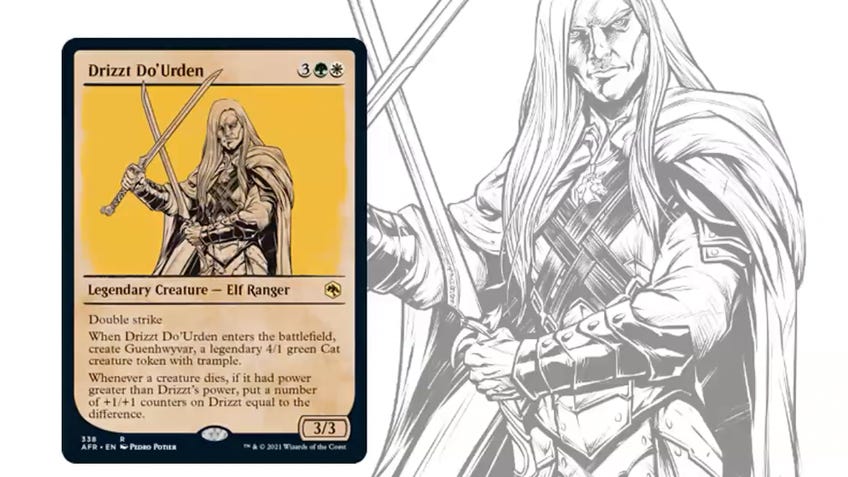
Dungeons & Dragons is probably best known for the characters we all make for ourselves, along with the NPCs that our ever-patient DMs come up with to guide us through or hinder us in our adventures. However, players who aren’t familiar with D&D’s wider lore might not realise that there are also many existing characters within the Forgotten Realms of some fame or infamy.
Adventures in the Forgotten Realms features a few of these well-known characters. Xanathar, Guild Kingpin, for example, is the beholder at the centre of the Xanathar Thieves’ Guild and here allows you to steal other people’s cards straight from their libraries.
Then you’ve got the likes of Drizzt Do’Urden, a drow ranger who became a hero of the North and was famed for using two blades at once. The star of the Icewind Dale novels is represented in the set as a creature with double strike who enters the battlefield alongside a cat token called Guenhwyvar, his panther companion.
There are plenty of these D&D characters throughout the set, and it’s interesting to see how they’ve been represented in a completely different game system.
2. Story beats
Choose your own Adventures
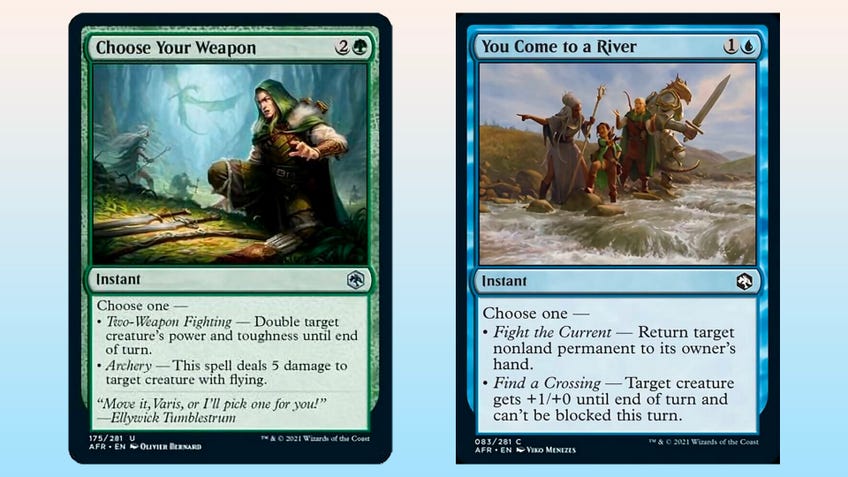
The core of Dungeons & Dragons is decision-making. Now, granted, those decisions are usually terrible - like deciding to try out the forbidden soup or needing to wear the fancy new black ring you found - but they’re still an integral part of the RPG. The ability to do what you want is what makes the system so much fun. Aside from the cards you play, and the modal cards that appear in sets - which are just cards with multiple modes of casting - it’s hard to get a feel for that in Magic: The Gathering.
Adventures in the Forgotten Realms manages to inject some decision-making by having cards literally named after classic D&D prompts like Choose Your Weapon and You Come to a River.
Choose your Weapon is a three-mana Green sorcery that allows you to either choose Two-Weapon Fighting or Archery. The former doubles a creature’s power and toughness until the end of turn, while the latter has the spell deal five damage to a creature with flying.
You Come to a River is a two-mana Blue instant that has you either trying to fight the current or find a crossing. Fighting results in a nonland permanent going back to its owner’s hand, whereas finding a crossing grants a creature +1/+0 until end of turn and stops them being blocked, too.
3. Skills
You’ve seen this before

Dungeons & Dragons has a lot of skills and spells. You’ll know that if you’ve ever tried to create a D&D 5E character, because it’s all rather terrifying to begin with - but by the time you get to later levels, you’ll be chaining skills together like a Tekken character. Magic: The Gathering always has mechanics in sets that will do a certain thing when you manage to meet a specific requirement. In Adventures in the Forgotten Realms, the two things have been fused.
What this basically means for the set is that there are a lot more mechanics than usual to learn. For example, Pack Tactics is a skill that appears in D&D as a way to give creatures an advantage if they have friends nearby. In MTG, it becomes an effect that causes something to happen if you attack with a group of creatures with a power of six or more. The actual effect changes based on the card it’s on - so you might be able to just draw a card, or you might be able to put a dragon into play from your hand that’s tapped and attacking.
4. Critical rolls
Pray for a natural 20
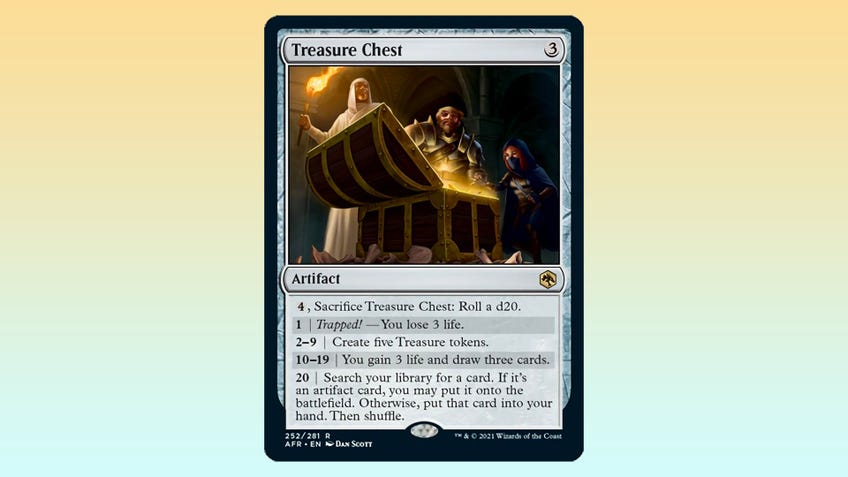
Everyone has, at some point, rolled a die and hoped for a specific outcome. Even if you don’t play Dungeons & Dragons specifically, you’ll no doubt have played something that requires you to get a particular result from the roll of a die - only to probably fail miserably and swear off dice for the rest of your life. You know, a perfectly reasonable reaction to something entirely chance-based.
Anyway, good news for those of you who have good luck: dice rolls are now in a Magic: The Gathering set again. The best example of this in Adventures in the Forgotten Realms is Treasure Chest, which is a three-mana artifact. When you pay four mana and sacrifice it, you have to roll D&D’s classic d20. If you get a 1, you lose three life; if you get 2-9, you create five Treasure tokens that you can sacrifice for one mana each; if you get 10-19, you gain three life and draw three cards. Those are all interesting, but if you roll a natural 20, you get to search your library for a card of your choice and then put it into play if it’s an artifact, or in your hand if it’s anything else.
5. Classes
But in a good way
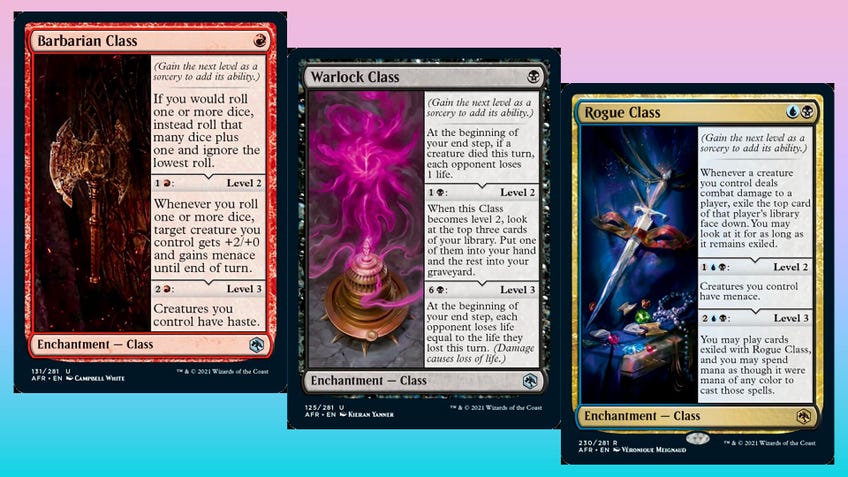
It’s nice to figure out roughly what you want to do with an RPG character before you properly invest in their skills. One of the first decisions everyone makes is which D&D class their character will be. With Adventures in the Forgotten Realms’ arrival, it turns out that MTG now has classes too. This was another element of Dungeons & Dragons we weren’t sure how they’d manage, but they’ve handled it well.
Classes in Adventures in the Forgotten Realms are enchantments. The first example we saw was Barbarian Class, which is a one-mana Red enchantment that effectively gives you advantage on your dice rolls, so you can roll two dice and then pick the higher of the two. What’s really cool is that they have multiple levels. You can pay extra mana to gain extra effects - almost like levelling up in D&D - with the Barbarian Class giving a creature +2/+0 and menace when you roll a die, and its final level giving all of your creatures haste.
6. Dragons
Roar!
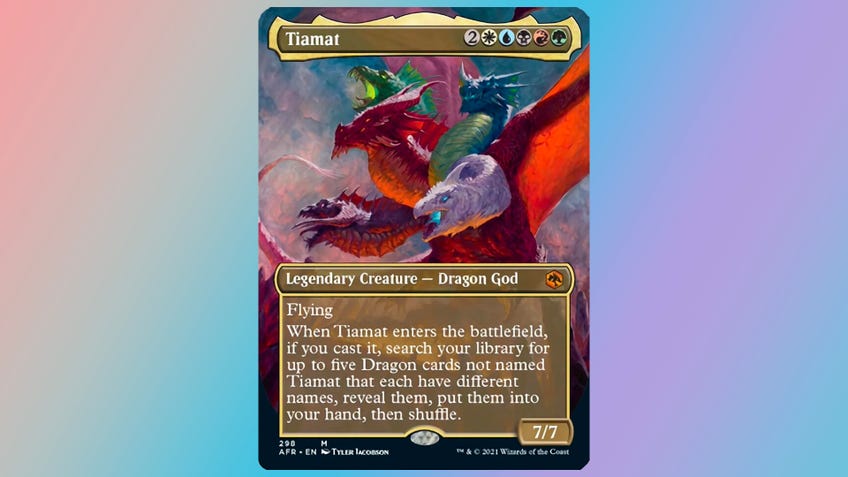
The first dragon we got to see in Adventures in the Forgotten Realms was Tiamat. Tiamat is a five-headed dragon god who is the mother queen of dragons and one of the main gods in Dungeons & Dragons lore. Dragons were obviously going to find themselves in a D&D MTG set in other ways, and there are a few cool examples of this.
Green Dragon, for example, is a six-mana 4/4 with flying and the Poison Breath ability. When it enters the battlefield, it causes any creature an opponent controls that is dealt damage to be destroyed. You’ve also got other named dragons, such as Icingdeath, Frost Tyrant. Icingdeath has nothing to do with overindulging in cakes, but is a four-mana White 4/3 with flying and vigilance. When it dies, you get to create a legendary White equipment called Icingdeath, Frost Tongue, which gives a creature +2/+0 and the ability to tap a creature whenever the equipped creature attacks.
7. Dungeons
Well, obviously
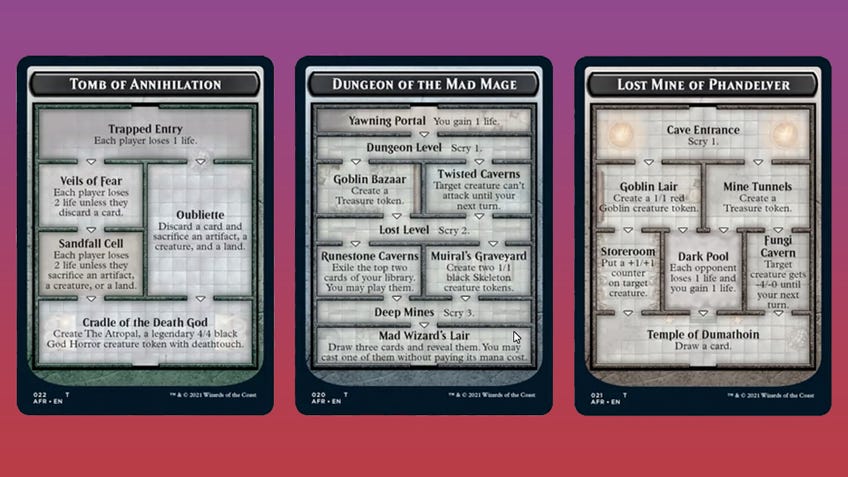
Finally, we have dungeons. This is the aspect of D&D in MTG that was probably the most mysterious. How do you put dungeon-crawling into a card game? The answer that Adventures in the Forgotten Realms found is a gameplay mechanic called Venture.
Dungeons can be accessed when a card has the phrase “Venture into the dungeon” on it, and has you journeying through different iconic D&D dungeons: Tomb of Annihilation, Dungeon of the Mad Mage and the Lost Mine of Phandelver. Both players always have access to the three dungeons in the game, and can choose to enter one or continue their journey through one whenever the Venture keyword triggers. Each room within the dungeons has a different effect, while other cards have special bonuses if you’ve already completed a dungeon during that game.
All of the D&D references in Adventures in the Forgotten Realms make for not only an interesting Magic: The Gathering set, but one that feels like it’s really doing both games justice. We can’t help but feel rather hopeful for other crossovers that are in the works, and the hope this will bring players from both universes together.
